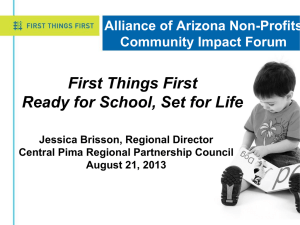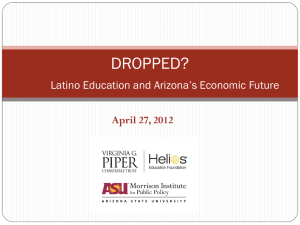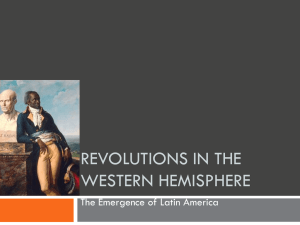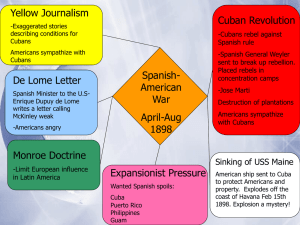Spanish Arrival into Arizona
advertisement
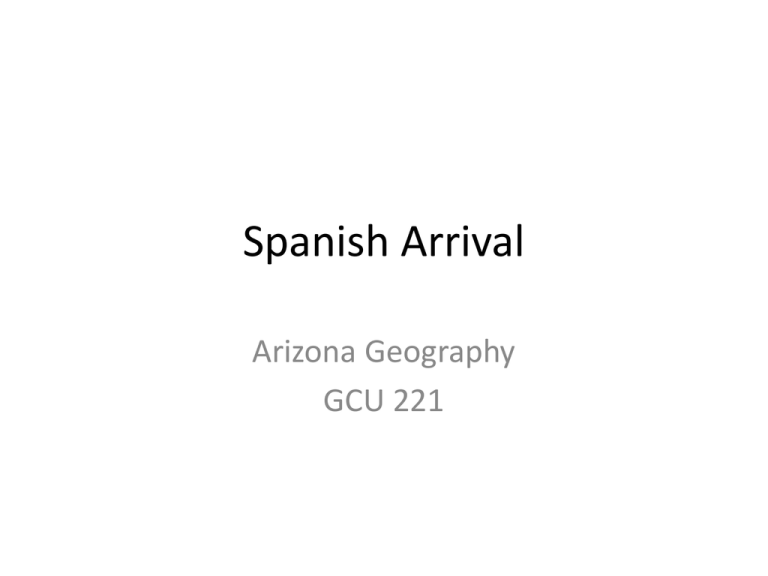
Spanish Arrival Arizona Geography GCU 221 Game Plan • • • • Columbus arrives in 1492 1528 Cabeza De Vaca survivors Coronado goes looking for gold Kino pushes Spanish control over most of southern Arizona (Pimería Alta) with Missions supported by surrounding ranches • Presidios established to support large ranches and silver mines: Tubac and Tucson • Revolts and Apache raiding weaken Spanish, and ousted with Mexican Independence Columbus arrives in 1492… why from Spain? Columbus arrives in 1492… why from Spain? Columbus arrives in 1492… why from Spain? Cabeza de Vaca and Gold Cities 1 of 3 survivors out of 600; expedition from 1528 to 1537. Talked of Cibola, the seven cities of gold. Followed by Hernando De Soto 1539 to 1542 Coronado goes looking for gold… 1540-1542 Coronado Expedition 1540-1542 (In the Cortez tradition) Kino Arrives in Arizona 1687 (a long way from 1492) • Extensive travels • Set up missions to convert native people to Christianity • Built nearby ranches to run cattle and horses, support missions • Raids by Apaches leads to the construction of presidios Kino Travels Explored 50,000 square miles of the southwest Kino Missions Mission San Xavier del Bac (1 of 20), built in 1700 near Tucson current version oldest Spanish building in Arizona that was rebuilt in 1797. Kino Ranches Spanish bring cattle and horses to Arizona, very successful. Resources support missions and keep native people from dispersing, supposed to prevent revolts. Tubac Presidio Apache raids and native unrest lead to the construction of Spanish military forts in Arizona, to protect the missions and surrounding ranches. Spanish Arizona Frontier country, where most people live a basic subsistence living. Native people periodically revolt the yolk of the Spanish, and everybody terrified of the constant Apache raids. Spanish Silver Mining Spanish mined silver in southern Arizona in the 1770s in Quijotoa, Aribac, and Arivaca. Pulled 300 tons of silver a year out of the new world, doubling or tripling the world’s precious metals. Biggest silver mine in the world Potisi at 13,000 feet in the Andes 25% to 50% of silver out of the new world was shipped to China. Used to trade for silk, spices, ivory, jade, and jewels. China needed a currency they could control. Biggest cities in the south begin to move to the north. Tenochtitlan, Aztec Empire Cuzco, Incan Empire Things to know: • Cabeza de Vaca stumble across Arizona, talk of gold • Cornado goes looking for gold, doesn’t find anything • Kino arrives in southern Arizona, sets up missions, ranches, and eventually presidios • Silver mining adds to Arizona’s worth • Spanish struggle with Apache and civil unrest Help: Ask Dr. Douglass

